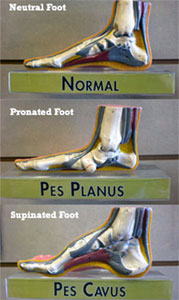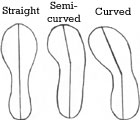
Kevin Conto received his athletic training degree
from the University of Wisconsin- Madison and obtained his Master of Physical
Therapy degree from Concordia University. He has his certification in manual
therapy from Maitland-Australian Physiotherapy Seminars and is currently a
physical therapist at United Hospital System. Kevin works with a variety of patient populations and also specializes
in industrial rehabilitation and orthotic fabrication.
The
market for shoes is vast and with so many selections available, how
do you determine which shoe is right for you? Having proper footwear
can not only help with protecting the foot but assist with absorbing
shock and providing stability as well (1). In the past most
people would have simply selected a shoe which fits, feels good, and
has previously worked for them. With advances in shoe technology,
there may be even more things to consider in the selection process
now.
Foot Types
 The
first step to selecting the right shoe is to be aware of your foot
type. Foot types can be categorized into three
classifications based on the height of the arches in the foot: 1) neutral foot
(normal arch) 2) pronated foot (lower arch) and 3) supinated foot
(higher arch). A neutral foot allows for
neutral pronation and is the most idea foot type as it will allow
for the most efficient type of gait. A pronated foot usually results
in the arches falling when the ankle rolls inward through the
loading phase in gait. A supinated foot, on the other hand, will not roll far
enough inwards through the loading phase which results in limited
motion at the arches through the gait cycle. By knowing your foot
type, this will allow for better understanding of why a shoe is
constructed in a certain manner and will also assist with
determining which shoe would be most appropriate.
The
first step to selecting the right shoe is to be aware of your foot
type. Foot types can be categorized into three
classifications based on the height of the arches in the foot: 1) neutral foot
(normal arch) 2) pronated foot (lower arch) and 3) supinated foot
(higher arch). A neutral foot allows for
neutral pronation and is the most idea foot type as it will allow
for the most efficient type of gait. A pronated foot usually results
in the arches falling when the ankle rolls inward through the
loading phase in gait. A supinated foot, on the other hand, will not roll far
enough inwards through the loading phase which results in limited
motion at the arches through the gait cycle. By knowing your foot
type, this will allow for better understanding of why a shoe is
constructed in a certain manner and will also assist with
determining which shoe would be most appropriate.
Anatomy of a Shoe
 The
next step for shoe selection is to have a better understanding of
the anatomy of a shoe. Shoes come in various shapes and sizes and
are constructed with various materials. Having a better
understanding of the anatomy and construction of a shoe will not
only help with shoe selection but will assist with increasing
comfort and minimizing injury as well. Below is a review of some of
the important
aspects in the construction of a shoe which will assist with providing
additional guidance with shoe selection.
The
next step for shoe selection is to have a better understanding of
the anatomy of a shoe. Shoes come in various shapes and sizes and
are constructed with various materials. Having a better
understanding of the anatomy and construction of a shoe will not
only help with shoe selection but will assist with increasing
comfort and minimizing injury as well. Below is a review of some of
the important
aspects in the construction of a shoe which will assist with providing
additional guidance with shoe selection.
Shoe Construction – Last
 If
you remove the insole of your shoe you should be able to see the
last of the shoe and how it is constructed. The last is the critical
element in footwear construction that determines the shoe's shape,
size, inner volume, fit, style, and specific stress points during
locomotion (2). The last of a shoe can
be constructed in three ways. 1) A shoe constructed with a cardboard
last is more stable and more suitable for individuals with flat
feet. 2) A shoe constructed with a combination last has cardboard in
the rear half and a stitched seam in the front half which allows it
to be more flexible than a cardboard last and more stable than a
slip last. 3) A shoe constructed with a slip last has a stitched
seam which is less stable and more suitable for individuals with
high arches (3).
If
you remove the insole of your shoe you should be able to see the
last of the shoe and how it is constructed. The last is the critical
element in footwear construction that determines the shoe's shape,
size, inner volume, fit, style, and specific stress points during
locomotion (2). The last of a shoe can
be constructed in three ways. 1) A shoe constructed with a cardboard
last is more stable and more suitable for individuals with flat
feet. 2) A shoe constructed with a combination last has cardboard in
the rear half and a stitched seam in the front half which allows it
to be more flexible than a cardboard last and more stable than a
slip last. 3) A shoe constructed with a slip last has a stitched
seam which is less stable and more suitable for individuals with
high arches (3).
 When
you inspect the last you should also examine its shape. In general
there are three main shapes of a last which can accommodate
differing foot types.1) A straight last is recommended for
individuals who have flat feet or have a tendency to over pronate.
2) A semi-curved last is recommended for individuals with normal
arches and 3) a curved last is recommended for individuals who have
high arches or have a tendency to over supinate (3).
When
you inspect the last you should also examine its shape. In general
there are three main shapes of a last which can accommodate
differing foot types.1) A straight last is recommended for
individuals who have flat feet or have a tendency to over pronate.
2) A semi-curved last is recommended for individuals with normal
arches and 3) a curved last is recommended for individuals who have
high arches or have a tendency to over supinate (3).
Shoe Construction – Upper
The upper is the top part of the shoe and is composed of the toe
box, vamp, tongue, laces and heel counter. The toe box and vamp
provide protection to the forefoot and toes. If the toe box is small
this can result in irritation or injury to the toes and nails (4). The
tongue and laces assist with proper fit and upper foot cushioning
while the heel counter plays a key role with stabilization of the rearfoot
(4). The heel counter can be constructed with chemical sheets
or thermoplastic. Heel counters which are constructed with
thermoplastics are more firm and will be able to provide more
support.
Shoe Construction – Midsole
The midsole is where the technology is for the shoe and assists with
shock absorption. This is where
many shoe manufacturer’s focus their research and development on.
The midsoles of shoes are usually constructed utilizing ethylene
vinyl acetate (EVA), polyurethane or a combination of softer and
firmer materials. EVA is a light material which can be compressed
but ages and wears out rapidly. Polyurethane, on the other hand, is
a denser and more durable material which lasts longer (4). Many shoe
manufactures are utilizing a multi-density midsole consisting of a
softer material for the lateral side to soften impact and a firmer
medial side for support (4).
This may be a lot of information to comprehend and may be somewhat
confusing. Provided below is a chart that organizes the information
which was discussed in this article and will provide some general
guidance and recommendations for shoe selection (1,2,3,4). You can also obtain
more information on finding the right shoe for you by utilizing the
Runner's World - Shoe Advisor.

Last revised: May 21, 2010
by Kevin Conto, MPT, L-ATC, COMT & Chai Rasavong, MPT, MBA
References
1. McPoil TG. Footwear. Physical Therapy
1988;68(12):1857-1865
2. Rossi WA. The neglect of footwear education of podiatry
students and practitioners. J Am Podiatry Med Assoc
1987;77:357-362.2.
3. Conto, K. 2010. Runner's Symposium. Pleasant Prairie, WI.
United Hospital System. pp 2-3.
4. http://www.dynamicchiropractic.com/mpacms/dc/article.php?id=38052


 The
first step to selecting the right shoe is to be aware of your foot
type. Foot types can be categorized into three
classifications based on the height of the arches in the foot: 1) neutral foot
(normal arch) 2) pronated foot (lower arch) and 3) supinated foot
(higher arch). A neutral foot allows for
neutral pronation and is the most idea foot type as it will allow
for the most efficient type of gait. A pronated foot usually results
in the arches falling when the ankle rolls inward through the
loading phase in gait. A supinated foot, on the other hand, will not roll far
enough inwards through the loading phase which results in limited
motion at the arches through the gait cycle. By knowing your foot
type, this will allow for better understanding of why a shoe is
constructed in a certain manner and will also assist with
determining which shoe would be most appropriate.
The
first step to selecting the right shoe is to be aware of your foot
type. Foot types can be categorized into three
classifications based on the height of the arches in the foot: 1) neutral foot
(normal arch) 2) pronated foot (lower arch) and 3) supinated foot
(higher arch). A neutral foot allows for
neutral pronation and is the most idea foot type as it will allow
for the most efficient type of gait. A pronated foot usually results
in the arches falling when the ankle rolls inward through the
loading phase in gait. A supinated foot, on the other hand, will not roll far
enough inwards through the loading phase which results in limited
motion at the arches through the gait cycle. By knowing your foot
type, this will allow for better understanding of why a shoe is
constructed in a certain manner and will also assist with
determining which shoe would be most appropriate. The
next step for shoe selection is to have a better understanding of
the anatomy of a shoe. Shoes come in various shapes and sizes and
are constructed with various materials. Having a better
understanding of the anatomy and construction of a shoe will not
only help with shoe selection but will assist with increasing
comfort and minimizing injury as well. Below is a review of some of
the important
aspects in the construction of a shoe which will assist with providing
additional guidance with shoe selection.
The
next step for shoe selection is to have a better understanding of
the anatomy of a shoe. Shoes come in various shapes and sizes and
are constructed with various materials. Having a better
understanding of the anatomy and construction of a shoe will not
only help with shoe selection but will assist with increasing
comfort and minimizing injury as well. Below is a review of some of
the important
aspects in the construction of a shoe which will assist with providing
additional guidance with shoe selection.  If
you remove the insole of your shoe you should be able to see the
last of the shoe and how it is constructed. The last is the critical
element in footwear construction that determines the shoe's shape,
size, inner volume, fit, style, and specific stress points during
locomotion (2). The last of a shoe can
be constructed in three ways. 1) A shoe constructed with a cardboard
last is more stable and more suitable for individuals with flat
feet. 2) A shoe constructed with a combination last has cardboard in
the rear half and a stitched seam in the front half which allows it
to be more flexible than a cardboard last and more stable than a
slip last. 3) A shoe constructed with a slip last has a stitched
seam which is less stable and more suitable for individuals with
high arches (3).
If
you remove the insole of your shoe you should be able to see the
last of the shoe and how it is constructed. The last is the critical
element in footwear construction that determines the shoe's shape,
size, inner volume, fit, style, and specific stress points during
locomotion (2). The last of a shoe can
be constructed in three ways. 1) A shoe constructed with a cardboard
last is more stable and more suitable for individuals with flat
feet. 2) A shoe constructed with a combination last has cardboard in
the rear half and a stitched seam in the front half which allows it
to be more flexible than a cardboard last and more stable than a
slip last. 3) A shoe constructed with a slip last has a stitched
seam which is less stable and more suitable for individuals with
high arches (3).  When
you inspect the last you should also examine its shape. In general
there are three main shapes of a last which can accommodate
differing foot types.1) A straight last is recommended for
individuals who have flat feet or have a tendency to over pronate.
2) A semi-curved last is recommended for individuals with normal
arches and 3) a curved last is recommended for individuals who have
high arches or have a tendency to over supinate (3).
When
you inspect the last you should also examine its shape. In general
there are three main shapes of a last which can accommodate
differing foot types.1) A straight last is recommended for
individuals who have flat feet or have a tendency to over pronate.
2) A semi-curved last is recommended for individuals with normal
arches and 3) a curved last is recommended for individuals who have
high arches or have a tendency to over supinate (3). 





